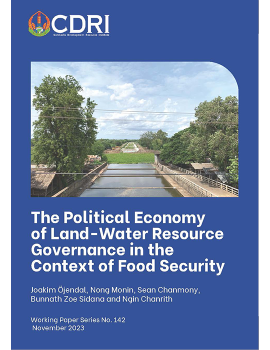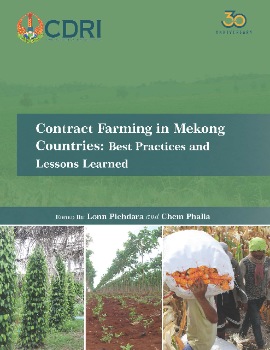
Climate Change and Migration Patterns: Findings at the Commune Level in Rural Provinces of Cambodia
Khmer PDF (56)
Abstract/Summary
Migration forces rural people to find more and better jobs, which is key in generating incomes to sustain livelihoods and ensure food security in times of environmental change. In addition to agricultural production, climate change affects health, water, and energy resources and causes migration and conflict. The impacts of climate change on men and women can also differ in terms of employment, natural resource management, social norms, gender stereotypes, socio[1]economic opportunities, and adaptation to new technologies. Greenhouse gas emissions from production, transportation, and energy consumption will increase in urban areas due to various developments such as infrastructure. At the same time, agricultural land and corresponding activities in rural areas may be at risk of abandonment due to migration to cities or neighbouring countries. Moreover, falling into debt is one of the main reasons why remote villagers, both men and women, migrate to find work in the cities. The reasons behind these debts can be related to crop damage caused by natural disasters or other associated events. The migration burdens elderly mothers or grandmothers who take care of the children and grandchildren left behind, in addition to the uptake of many other household responsibilities.
Using a mixed-method approach, this study examined the association between climate change and migration in the three Cambodian communes of Kratie, Mondulkiri, and Steung Treng Provinces. Data was collected from 240 households with migrant members. The study aimed: (1) To understand trends of past and present weather and migrations patterns in rural communities of Cambodia, and (2) to analyse how climate change impacts migration patterns and suggest sustainable coping strategies appropriate for rural settings.
This study suggests that climate change and migration are linked. Temperatures have increased, and the rainy and dry seasons have become irregular. The income loss from damaged crops caused by extreme weather events is one of the causes of migration. Usually, villagers migrate short-term to ensure their family has enough money to survive; after earning enough money, they return to their farming activities. Most migrants are of working age and migrate to the capital city of their province or other provinces to work in garment factories, construction sites, or labouring work.
Political factors do not seem significant in influencing migration and its patterns. Furthermore, climate hazards, such as droughts, high temperatures, floods, and windstorms, were also not perceived as direct causes of migration. Some villagers faced family burdens, dependency, and health issues yet believed those factors were unlikely to contribute to the migration. This study finds that social and economic drivers were the key factors pushing people to migrate. These include poverty, indebtedness, transfer of workplace to another location, searching for the right jobs, food insecurity, unemployment, lost land or house, and decreased crop yields.
The study suggests that climate change-induced extreme events are the root causes of losses and damages, destroying properties or assets, crops, livestock, and poultries, leading to income loss and poverty. Poverty and indebtedness firmly push family members to migrate for better employment opportunities.
To improve local livelihoods and
reduce migration, the following recommendations are suggested:
(1) Provide
training on agricultural practices that are resilient to climate change.
(2) Provide
irrigation systems and training on practical water usage to improve
agricultural production and yields, diversify agrarian activities, and increase
local farming jobs.
(3) Enhance local participation
and active engagement in community development planning and decision-making
processes toward improving climate resiliency.



